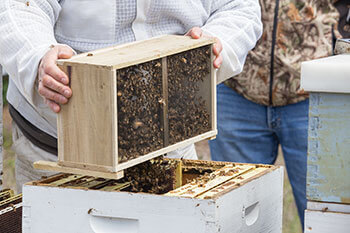
You’ve made the leap and are ready to get bees, but the choices are a little overwhelming. So many options and how do you compare? What is the best way to start out? And most importantly, what kinds of questions should you ask of your bee supplier to truly understand what you are receiving? Not all bees are created equal; often if the price is low, so is the quality.
There are three main ways that new beekeepers obtain their first bees:
Each source of bees is described in detail below, listing the pros and cons. The ease of installation and the cost are rated on a scale of 1 to 5, with 1 being the easiest and least expensive.
- A package
- A nucleus colony abbreviated nuc
- A swarm
Packages
Packages are typically sold as 2 or 3 lbs. packages of bees. They come in a wood or plastic mesh box with a feeder can of sugar syrup and a mated queen. They are either shipped via mail or picked up directly from a supplier. Often beekeeping clubs will bulk order packages and make them available to members at a specific price.
Most packages are produced in our southern states and the quality of them can vary greatly, from excellent to subpar. To produce packages, large commercial beekeepers typically shake excess adult bees from their colonies into a big collector box. These are then funneled into the packages until there are enough bees to reach the desired weight. A mated queen in a cage is added into the package. Most package producers are making thousands of packages at once and then shipping them north.
Pros:
- Packages are typically less expensive, ranging in price from $90-175
- They can easily be installed into non-standard colonies like top bars, long lang or Warre hives.
- They are often available early in the season.
Cons:
- The bees will occasionally abscond, meaning they fly away in search of different accommodations. This is not uncommon when installed onto brand new equipment that has never housed bees before, because it doesn’t smell like home.
- Sometimes they arrive during inclement weather when temperatures suddenly drop in the spring, making it difficult to keep them alive.
- Because queens are produced en masse for packages, they are not always well mated. Some produce poor brood patterns, while others only lay drones. It has become more common for the package queens to be replaced by the bees within one month of installation.
- Packages can overheat during transport and negative effects are not always immediately apparent.
Ease of Installation: 3
Cost: 3
Nucs
Nucs are typically sold as 4 or 5 frame nucs. They can be ordered as deep or medium frames, depending on the producer. They are a complete miniature colony that contains all the resources needed to start, kind of like getting a puppy that grows into a full size dog by the end of that first season.
Pros:
- A nuc is the easiest type of colony for a beginner
- The queen has already been accepted by the bees and the unit functions as a whole
- A nuc typically comes with 3-4 frames of brood in all stages of development, plus 1-2 frames of pollen and honey.
- They are often locally produced and may be better adapted to the region, if the seller is producing the queens locally.
Cons:
The cost of the nuc is often ….


